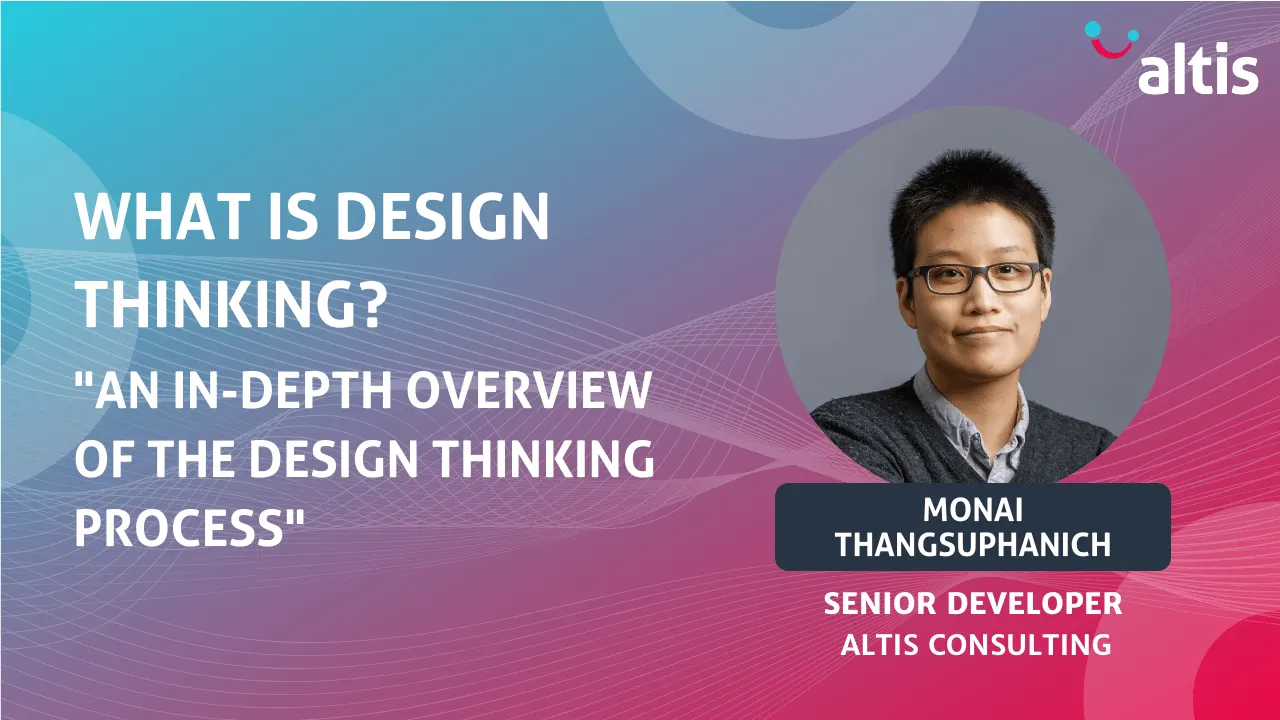
By Monai Thangsuphanich, Senior Developer – Altis Sydney
In this webinar, we discussed an in-depth overview of the design thinking process and how our Innovation team uses this process to design and develop new products.
What is Design Thinking?
When you are searching for articles on design thinking, there are several good definitions of design thinking. However, I personally like Tim Brown’s definition most.
“Design thinking is a human-centered approach to innovation that draws from the designer’s toolkit to integrate the needs of people, the possibilities of technology, and the requirements for business success.” – Tim Brown, Chair of IDEO [1]
Why is it important?
New products require innovation to become successful products, and innovation requires 3 things – desirability, viability and feasibility as shown in Figure 1.

Since the desirability aspect is quite easy to miss, we need a process to help us keep the desirability aspect in our product requirements. Design thinking is the process that could help achieve this task.
The Process
Design thinking is a non-linear process consisting of 5 stages that can be illustrated in Figure 2.

Empathise
This stage focuses on understanding your users’ needs thoroughly by studying and observing their behaviours and feelings.
Since trying to understand what users think or feel is more difficult as we cannot observe that information directly, psychology knowledge helps us to interpret people’s thoughts and feelings from their behaviours.
Examples of tools that help us work in the empathise stage are empathy map (Figure 3) and Maslow’s hierarchy of needs (Figure 4).


Define
This stage focuses on identifying the problem and defining an actionable problem statement. It is the most impactful stage but also the most challenging part of the process.
A good problem statement that we receive from this stage should be:
- Human-centred
- Broad enough to be creative
- Narrow enough to be manageable
Usually, this stage will be combined with the ideate stage as they overlap each other.
Ideate
This stage focuses on generating lots of ideas in the form of questions and solutions, then cutting down into the best and practical idea to implement in the prototype and test stages.
Examples of tools that help with ideation are brainstorming and mind maps.
Prototype
This stage focuses on producing an early, inexpensive and scaled-down version of the product/feature to be used later in the test stage. The prototype can be low-fidelity or high-fidelity, depending on the project budget and goals.
Test
Sometimes known as “usability testing”, this stage focuses on testing and revealing any problems with the idea/design and is usually undertaken concurrently with the prototype stage.
With the current pandemic, there is a rising trend in remote testing due to the limitation of movement and public health orders. Having a stable and fast internet connection, and an organised facilitator to guide through the usability testing help improving the test result accuracy when performing remote testing.
To achieve the best results from usability testing, earlier research suggested running each test with no more than 5 users and running multiple small tests as many as you can afford [6].
Key Takeaway
As you are designing and developing any products/features, you should always have this question in mind:
Does your solution solve the user’s pain point?
Since it is easy to get distracted from focusing on the user, the design thinking process helps to keep this question in the team’s mind.
If you find learning and practising design thinking challenging, contact us to request a design thinking workshop to upskill your team.
If you’d like to learn more, watch the entire webinar recording below.
Interested in watching more of our past webinars? View our previous Free Data & Analytics webinar recordings here.
References
- IDEO, “Design Thinking Defined,” IDEO Design Thinking. [Online]. Available: https://designthinking.ideo.com/.
- The Framework Bank, “A Venn Diagram for Innovation,” Medium, 2016. [Online]. Available: https://jenbonhomme.medium.com/a-venn-diagram-for-innovation-5097ba91a1c6.
- Interaction Design Foundation, “Design Thinking.” [Online]. Available: https://www.interaction-design.org/literature/topics/design-thinking.
- Innovation Training, “Empathy Map Template Training.” [Online]. Available: https://www.innovationtraining.org/empathy-map-template-training/.
- D. S. McLeod, “Maslow’s Hierarchy of Needs,” Simply Psychology, 2020. [Online]. Available: https://www.simplypsychology.org/maslow.html.
- J. Nielsen, “Why You Only Need to Test with 5 Users,” Nielsen Norman Group Articles, 2000. [Online]. Available: https://www.nngroup.com/articles/why-you-only-need-to-test-with-5-users/.
